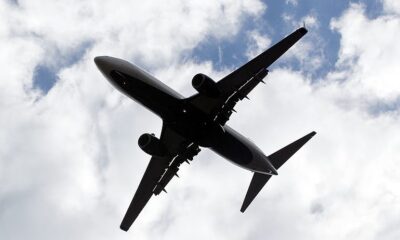Travel
Italy fines Roman Colosseum ticketing agencies €20m for practices that forced tourists to pay more
Italy’s competition authority on Tuesday levied fines totaling €20 million against half a dozen tour operators for ticket hoarding practices, which made it nearly impossible for regular visitors to buy basic tickets online to visit the landmark Roman Colosseum.
An investigation began in July 2023 following widespread complaints about how it was nearly impossible to buy tickets at official prices online.
The country’s antitrust authority, ACGM, said that this ticketing hoarding led to the “substantial and prolonged unavailability” of standard-priced tickets for Italy’s most popular tourist attraction.
Tourists were instead forced to buy higher-priced tickets bundled with additional services like tour guides or the chance to skip the line.
The Colosseum director declined to comment on the fines, his office said. It said the Colosseum was Italy’s most-visited monument in 2023, with over 12.3 million visitors.
How were agencies making it almost impossible to buy tickets?
The Cooperative Culture Society, which managed ticket sales for the Colosseum from 1997 to 2024, received the largest portion of the overall fine at €7 million. This was for failing to prevent automated ticket hoarding and for reserving a large share of tickets for its own guided tour packages.
Six tour operators based in Italy, Germany, the Netherlands and Ireland were also fined for using bots and other automated systems to buy up large quantities of tickets, making them unavailable for individual tourists.
The authority did not list the mark-ups, but the Archaeological Park of the Colosseum which is operated by the Italian Culture Ministry, lists the price for access to the ancient Roman arena at €18 for adults.
For that price, visitors can spend 20 minutes on the Colosseum’s main floor.
Travel
Is Norway introducing a visitor tax? Here’s all we know about its proposal to tackle overtourism
Norway has updated its plans for a visitor tax that hopes to tackle the negative effects of overtourism.
The government has announced it is lowering the proposed fee that local authorities will be able to charge tourists.
Minister of Trade and Industry Cecilie Myrseth has confirmed the tax will now be three per cent of the cost of an overnight stay – instead of five per cent.
Norway is experiencing a surge in arrivals as holidaymakers seek cooler climes, hitting a record-breaking 16.7 million overnight stays during the summer months of 2024.
Norway is bringing in a tourist tax
Norway’s tourist tax will be an optional charge that can be levied at the discretion of local authorities.
The revenue will be used to fund projects that will benefit both residents and tourists, such as maintaining hiking trails and installing public toilets.
If implemented by a municipality, the levy will apply to visitors staying in all overnight accommodation, including hotels, hostels, campsites and short-term rentals.
Local authorities can also adjust the fee depending on the season, Myrseth confirmed.
“It is not the case that we have year-round tourism throughout the country, but in some places, there are parts of the year that are particularly demanding, and the expenses that the residents have to pay for are particularly high,” Myserth told Norwegian public broadcaster NRK.
At the moment, there is no fixed date for the introduction of the visitor fee, though reports say it may come in as early as this summer.
The government still needs to have the bill detailing the tax approved by parliament, but several parties appear to be in opposition to the new levy.
The travel and tourism branch of the Confederation of Norwegian Enterprise (NHO) has warned it could put tourists off visiting the destination.
“We are now in a very serious situation. Introducing the tourist tax now is, in any case, madness,” a spokesperson from the NHO told NRK earlier this week.
The proposed tax has also been criticised for only targeting overnight visitors, leaving cruise passengers, day-trippers, and campervanners staying overnight in free public areas not required to pay.
Opponents argue that these are some of the most damaging kinds of visitors, particularly in frequently overwhelmed cruise destinations like the Lofoten Islands and Geiranger fjord.
Norway is experiencing a tourism surge
The Norwegian government has been mulling the introduction of a tourist tax for several years in reaction to surging visitor numbers.
Sweltering temperatures in traditional summer destinations like Italy and Spain are driving a trend for ‘coolcations’ in northern Europe.
Bolstering this is the rising interest in experiencing after-dark phenomena – dubbed ‘noctourism’ – such as the northern lights.
Norway is considered one of the best places for aurora-chasing, and the celestial spectacle is proving to be particularly visible in 2025.
Travel
Rattlesnakes, rocks and a Rolex: The weirdest things left behind in unclaimed luggage
There’s nothing more frustrating than arriving at your destination and discovering your bag didn’t make it.
In 2024, over 36 million bags were mishandled by airlines – either lost, stolen or damaged. That’s around seven bags for every thousand checked in. While many bags are ultimately reunited with their owner, a small percentage are lost forever.
Most bags contain nothing more than mundane items of clothing and a few toiletries. But some people travel with much stranger belongings – a suit of armour, a toilet seat, and even a glass eye have all been retrieved from lost bags over the past year.
According to Unclaimed Baggage, a US-based retailer that sells items from unclaimed airline luggage, these odd items are just the tip of the iceberg. Its Found Report uncovers the strangest, most expensive and most commonly lost items reclaimed from airline baggage.
“Since 1970, we’ve unpacked more than just belongings—we’ve discovered the unique stories behind travellers’ journeys,” said CEO & President Bryan Owens. “From the most valuable to the trendy, the ‘Found Report’ gives readers a first-class seat to the most compelling tales uncovered from the previous year.”
Weird and wonderful finds that boggle the mind
Some of the items found by Unclaimed Baggage in travellers’ suitcases last year are head-scratchingly strange.
Take, for instance, the full breastplate from a medieval suit of armour or the Roman soldier’s helmet. The company didn’t say if these came out of the same bag, but given they’re from different historical periods, they probably didn’t – no self-respecting live-action role-player would dare mix up their eras.
One bag contained a freeze-dried chicken’s foot, which you could wash down with a jar of whiskey containing a preserved rattlesnake from another. If that creeps you out, how about opening a bag to find no clothes, no toothpaste, just dozens of enormous spiders and beetles preserved in cases.
Historical items were flying around the world more than you’d expect. Passengers’ luggage contained all sorts of ancient treasures, from an antique mustache curler to a decades-old magician’s hat.
Probably the most disturbing find, however, was an antique French book on performing exorcisms. Who knows what the ultimate intent for that particular item would have been?
And then there was the just plain weird – a silicon pregnancy belly, a pair of silicone butt pads and a full set of dentures complete with tooth jewels.
One bag in particular had the Unclaimed Baggage workers hot under the collar. The team said, “There are heavy bags, and then there was this bag.”
When the heavyweight suitcase was hauled in to be unpacked, workers were eager to see what was inside. Gold bars? Ancient artefacts? Something special for sure, given its ridiculous weight.
Sadly, the case opened to reveal… rocks. Nothing else. Just rocks. Perhaps this was a misguided geologist’s collection or some strange attempt at weight training, but we’ll never know.
High class luxuries in unclaimed baggage
Not all the items recovered were just plain weird – some were weirdly expensive, raising questions about why people wouldn’t try harder to track them down.
The most expensive item found in an unclaimed bag was an 18-karat white gold solitaire diamond ring, thought to be worth around $39,000 (€34,000). There was also a gold President Oyster Rolex watch, valued at around $20,000 (€17,500).
Among the other lost luxuries were designer garments from the likes of Chanel and Alexander McQueen worth thousands, and pieces of Louis Vuitton luggage that on their own would fetch more than $10k (€17,500+).
Expensive cameras, designer dog carriers and a $7,000 (€6,200) handmade flute all came out of lost bags last year too.
What else do we leave behind on our travels?
It’s not only lost luggage from airlines that tell a tale about how we travel today. Uber’s annual lost and found index, also released this week, details what its drivers find left behind in their cars.
Predictably, the most commonly lost items include phones, wallets, keys and headphones. An incredible 1.7 million phones were left in rideshare cars last year, and more than 70 Nintendo Switch consoles.
But those aren’t the strangest things Uber drivers have found, not by a long way. Among the most ‘unique’ finds were a chainsaw, a DNA testing kit, 10 live lobsters and a urinal.
Apparently we’re prone to leaving things in hotel rooms, too. Hotels.com released its ‘Innsights’ report last year, revealing a car tyre, an engagement ring, a tooth, two full-leg casts, stacks of cash, a pet lizard, and a chick were all among the items forgotten by travellers when they checked out.
TFL, the company that runs the London public transport network, has a warehouse of unclaimed belongings and gets around 6,000 new items every week. Among these lost items have been a box of cooked frogs, a glass jar filled with bats, a Dalek costume and a puffer fish.
How to avoid losing your luggage
While the contents of some of these bags beg the question ‘why’, the fact remains that if you don’t want your weird travel companions to be discovered, don’t lose your bag.
Avoiding checking a bag in is a great strategy, as your luggage will stay with you at all times. Some airlines have quite generous allowances for carry-on baggage, so consider if you can avoid the unknown by travelling light.
If you do need to check in a bag, make sure you can spot it from a mile away. Bright straps, coloured ribbons and unique stickers will all help your luggage stand out on the carousel among all the other black cases.
Many lost bag incidents occur during connecting flights. If you can, choose a direct flight to minimise the chance of disruption during the connection.
For the ultimate peace of mind, Apple’s AirTag product has become a passenger favourite for keeping an eye on your bag. As they rely on Bluetooth via the ‘Find My’ network, tracking can be more reliable than GPS alone and can help you pinpoint a missing bag rapidly from anywhere in the world.
If the worst does happen and you become separated from your luggage, it’s essential to report it immediately to the company you were travelling with. For air travel, the airport will ask you to complete a Property Irregularity Report (PIR), which will generate a reference number to help you track progress.
While the airline is looking for your luggage, they will usually reimburse you for essential items you need to purchase, such as toiletries or clothes. If after 21 days the bag still hasn’t been found, you’ll be able to claim compensation.
Airlines have a maximum liability for lost luggage, typically around €1,600 per passenger, but it does vary. Any unclaimed luggage is usually sold, donated or disposed of.
In the US, airlines will search for the owners of bags for 90 days, but if the luggage is still unclaimed by that point, it ends up with Unclaimed Baggage at its store in Scottsboro, Alabama. The contents are catalogued and either placed for sale in its retail store, repurposed for charity or recycled.
Ultimately, you can spare yourself the grief of losing a treasured possession by simply not travelling with it at all. While you might love them very much, it’s probably best to leave the armor, arachnids, and ancient artefacts where they belong—safely at home.
Travel
Hiking in Cinque Terre this spring? Be prepared for footwear checks and one-way systems
Italy’s Cinque Terre is famous for its sunny-coloured, cliff-clinging villages linked by vertiginous walking paths.
The hiking routes draw thousands of visitors in spring and summer, to the extent that the Cinque Terre national park authorities have had to introduce safety measures.
With the upcoming Easter holidays expected to be particularly busy, officials are tightening regulations.
Cinque Terre trails will have one-way systems on busy days
During peak season, one-way systems are often implemented on popular stretches of the Cinque Terre’s hiking routes.
The Sentiero Verde Azzurro winds all the way from Monterosso al Mare to Riomaggiore, passing through Vernazza, Corniglia and Manarola on the way.
On the days predicted to be the busiest in April, May and June this year, the Monterosso-Vernazza leg of the trail will be one-way from 9am to 2pm.
During this time, walkers will only be able to go from the town of Monterosso towards Vernazza, the direction that 70 per cent of visitors choose according to people counts done in previous years.
The one-way system will be active 19-21 and 25-27 April, 1, 29 and 31 May, and 1-2 June.
“This measure, already successfully tested in 2023 and 2024, is aimed at improving the use of the trail and ensuring the safety of visitors by avoiding dangerous intersections and congestion along a particularly narrow and steep path,” the Cinque Terre national park authorities say on their website.
It also aims to protect the ancient dry stone walls that run along this section of the path.
To enter the park, hikers also need to purchase a Cinque Terre Trekking Card, which starts at €7.50 per day or €15 on peak days.
Cinque Terre hikers will undergo footwear checks
Park authorities brought in a ban on open or smooth-soled footwear (like flip-flops) in 2019.
Inappropriate shoes can cost a would-be hiker a fine ranging from €50 to €2,500.
In the latest online guidelines for visiting the park, officials now say checks will be carried out to ensure walkers are properly kitted out.
Cinque Terre ‘Path of Love’ caps visitor numbers
In 2024, the famous Via dell’Amore or ‘Path of Love’, reopened after being closed for over a decade by a landslide.
Known as the most romantic walk in the world, it connects Riomaggiore and Manarola.
As one of the most famous stretches of the Cinque Terre coastline, the Via dell’Amore is massively popular with visitors.
To curb overtourism, there is a booking system for those who want to walk the path.
The number of visitors allowed on the path each hour is capped at 400, and walkers have to book their tickets online or purchase one at the park’s ticket booths.
The tickets cost €12.50, which also includes the Cinque Terre Trekking Card and entrance to the Castle of Riomaggiore.
Other hiking routes are ‘less congested and equally panoramic’
As well as bringing in restrictions, park authorities are seeking to reduce overcrowding by reminding visitors that there are plenty of other routes to explore.
Other sections of the Sentiero Verde Azzurro will remain passable in both directions this summer.
The same goes for the rest of the park’s hiking network, which includes over 130km of routes between the coast and mountain ridges.
“It is a wide and suggestive network, which offers valid alternatives that are less congested and equally panoramic,” park authorities say.
-

 EU & the World3 days ago
EU & the World3 days agoWhere to Watch the Masters: Can I Stream the Live Coverage?
-

 EU & the World2 days ago
EU & the World2 days agoPlane Crash in Boca Raton: What Happened & Updates on the Accident
-

 EU & the World3 days ago
EU & the World3 days agoJillian ‘Lauren’ Shriner: 5 Things About the Weezer Bassist’s Wife
-

 Sports3 days ago
Sports3 days agoConference League 2024-2025, Legia Warsaw-Chelsea: the likely lineups
-

 Sports2 days ago
Sports2 days agoCarlos Alcaraz takes big risk but hits semifinal in Monte Carlo
-

 Sports7 days ago
Sports7 days agoSerie A 2024-2025: Torino-Verona, the likely lineups
-

 Sports7 days ago
Sports7 days agoAlexander Zverev dates Jannik Sinner in Rome final
-

 Sports6 days ago
Sports6 days agoElisa Longo Borghini: sports career, personal interests, family, awards and honors









